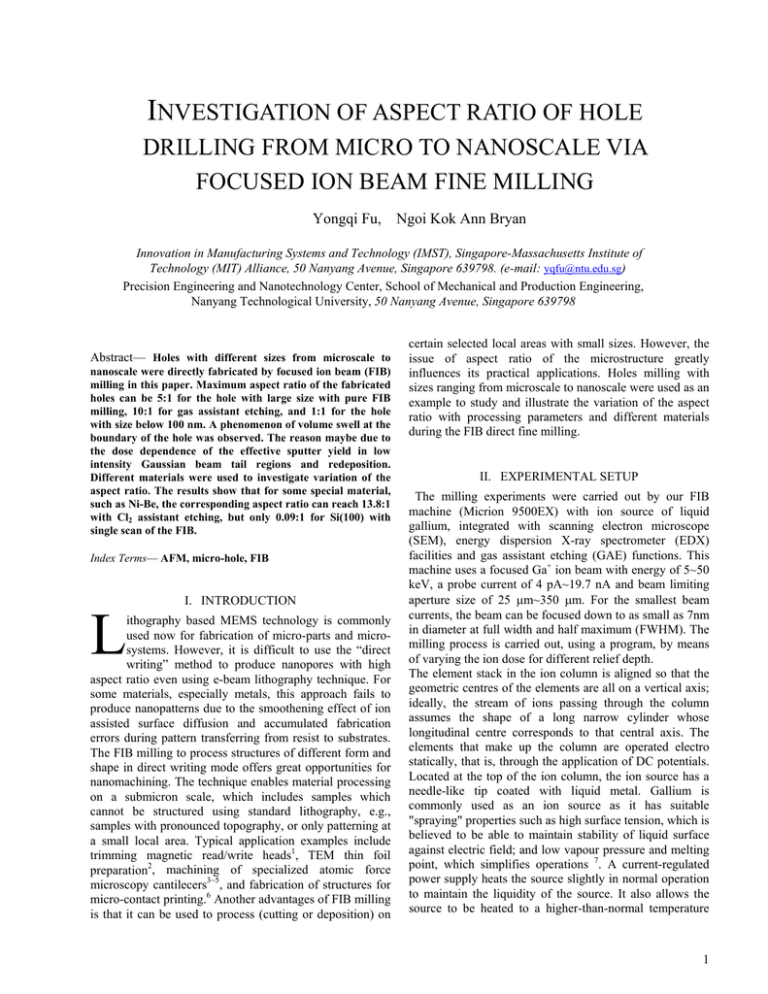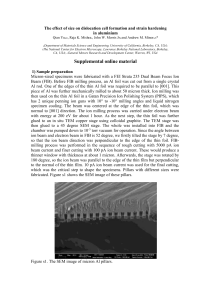I
advertisement

INVESTIGATION OF ASPECT RATIO OF HOLE DRILLING FROM MICRO TO NANOSCALE VIA FOCUSED ION BEAM FINE MILLING Yongqi Fu, Ngoi Kok Ann Bryan Innovation in Manufacturing Systems and Technology (IMST), Singapore-Massachusetts Institute of Technology (MIT) Alliance, 50 Nanyang Avenue, Singapore 639798. (e-mail: yqfu@ntu.edu.sg) Precision Engineering and Nanotechnology Center, School of Mechanical and Production Engineering, Nanyang Technological University, 50 Nanyang Avenue, Singapore 639798 Abstract— Holes with different sizes from microscale to nanoscale were directly fabricated by focused ion beam (FIB) milling in this paper. Maximum aspect ratio of the fabricated holes can be 5:1 for the hole with large size with pure FIB milling, 10:1 for gas assistant etching, and 1:1 for the hole with size below 100 nm. A phenomenon of volume swell at the boundary of the hole was observed. The reason maybe due to the dose dependence of the effective sputter yield in low intensity Gaussian beam tail regions and redeposition. Different materials were used to investigate variation of the aspect ratio. The results show that for some special material, such as Ni-Be, the corresponding aspect ratio can reach 13.8:1 with Cl2 assistant etching, but only 0.09:1 for Si(100) with single scan of the FIB. Index Terms— AFM, micro-hole, FIB I. INTRODUCTION L ithography based MEMS technology is commonly used now for fabrication of micro-parts and microsystems. However, it is difficult to use the “direct writing” method to produce nanopores with high aspect ratio even using e-beam lithography technique. For some materials, especially metals, this approach fails to produce nanopatterns due to the smoothening effect of ion assisted surface diffusion and accumulated fabrication errors during pattern transferring from resist to substrates. The FIB milling to process structures of different form and shape in direct writing mode offers great opportunities for nanomachining. The technique enables material processing on a submicron scale, which includes samples which cannot be structured using standard lithography, e.g., samples with pronounced topography, or only patterning at a small local area. Typical application examples include trimming magnetic read/write heads1, TEM thin foil preparation2, machining of specialized atomic force microscopy cantilecers3~5, and fabrication of structures for micro-contact printing.6 Another advantages of FIB milling is that it can be used to process (cutting or deposition) on certain selected local areas with small sizes. However, the issue of aspect ratio of the microstructure greatly influences its practical applications. Holes milling with sizes ranging from microscale to nanoscale were used as an example to study and illustrate the variation of the aspect ratio with processing parameters and different materials during the FIB direct fine milling. II. EXPERIMENTAL SETUP The milling experiments were carried out by our FIB machine (Micrion 9500EX) with ion source of liquid gallium, integrated with scanning electron microscope (SEM), energy dispersion X-ray spectrometer (EDX) facilities and gas assistant etching (GAE) functions. This machine uses a focused Ga+ ion beam with energy of 5~50 keV, a probe current of 4 pA~19.7 nA and beam limiting aperture size of 25 µm~350 µm. For the smallest beam currents, the beam can be focused down to as small as 7nm in diameter at full width and half maximum (FWHM). The milling process is carried out, using a program, by means of varying the ion dose for different relief depth. The element stack in the ion column is aligned so that the geometric centres of the elements are all on a vertical axis; ideally, the stream of ions passing through the column assumes the shape of a long narrow cylinder whose longitudinal centre corresponds to that central axis. The elements that make up the column are operated electro statically, that is, through the application of DC potentials. Located at the top of the ion column, the ion source has a needle-like tip coated with liquid metal. Gallium is commonly used as an ion source as it has suitable "spraying" properties such as high surface tension, which is believed to be able to maintain stability of liquid surface against electric field; and low vapour pressure and melting point, which simplifies operations 7. A current-regulated power supply heats the source slightly in normal operation to maintain the liquidity of the source. It also allows the source to be heated to a higher-than-normal temperature 1 when necessary to eliminate impurities and to otherwise condition it for emission. The source is held at a very high positive potential relative to ground, typically 50 kV. This potential is called the acceleration voltage because, when the ions are extracted from the source, it is the force exerted by this difference in electrical potential that causes them to accelerate through the column to reach ground potential. The higher the acceleration voltage, the faster the ions are travelling as they exit the column and the greater the energy they impart to the specimen. In the ionisation process, liquid metal atoms tend to lose electron(s), thus becoming positive ions. An ion is an atom that has assumed a positive or negative electrical charge by virtue of losing or gaining electrons. Being charged particles, ions can be accelerated, focused, and otherwise controlled by electrostatic fields, and their relatively high mass (compared with that of subatomic particles) allows them to be used to induce the milling and deposition effects. The hole drilling was realized by two ways. One is nanopatternning by use of bitmap function of our machine7. We call it bitmap function. A designed pattern with bitmap format of *.XBM was prepared first. Then this pattern can be called in a defined area. After start milling, the FIB can direct write the pattern by deflection of the beam in terms of bitmap file. Micro-holes were directly fabricated using this method. The other is pixel space controlling method. We call it pixel space mode hereinafter. The pixel spaces in both horizontal and vertical directions are set to be large enough that center distance is more than two times of the hole diameter. Overlapping among pixels is zero. The diameter of the hole is determined by the beam spot size in this case. It is a result of repeated scanning of the beam with Gaussian distribution. The scanning times is controlled in terms of the total milling time, which determines the final depth of the micro-hole. Fig.2 Two dimensional profile of the micro-holes measured by use of AFM with tapping mode. Fig.3 FIB image of the micro-holes fabricated by FIB milling with ion energy of 50 keV, beam current of 8 pA on Si(111). III. EXPERIMENTAL RESULTS AND DISCUSSION Fig.1 is array of square micro-holes on Si(100), each array with 10×10 square holes was milled with bitmap function Fig.4 Two dimensional profile of the micro-holes fabricated by FIB milling with bitmap function and ion energy of 50 keV, beam current of 8 pA on Si(111), measured by use of AFM with tapping mode. Fig.1 Arrays of square micro-holes on Si (100), each array was milled using rectangular modify box of 10×10 µm2 with ion dose of 1 nC/ µm2; 10×10 square holes. 2 of our FIB machine in a defined area of 10×10 µm2 with ion dose of 1 nC/ µm2. Using the SEM, it was estimated that these arrays have maximum height variation between no influence on the depth in this case (single scan). The diameter is mainly determined by the focusing status of the beam spot. This kind of nano-hole array maybe useful as a (a) Fig.5 Top view of the micro-holes (drilled by the FIB bitmap function) measured by use of AFM with tapping mode. Elliptical shape was formed due to stage shifting caused by vibration during milling process. 680 nm and 720 nm. Each feature is repeated about 1 µm from the other except the round holes, which is 1.11 µm, meaning that the gap between each of them is 0.5 µm and 0.556 µm, respectively. Aspect ratio of the hole measured by AFM with tapping mode is 1.44, as shown in Fig.2. Fig.3 and Fig.4 are FIB images of the nano-hole array fabricated by the FIB milling on Si(100) with ion energy of 50 keV and bitmap function also, beam current is 8 pA. Diameter and depth of the hole measured by the AFM with tapping mode are 87.8 nm and 55 nm (aspect ratio is 0.63), respectively. Because of the beam deflection error and stage slightly shifting caused by vibration during the FIB scanning process, the hole shape changed from designed circle to be elliptical, as shown in Fig.5. It is not apparent for the holes with large diameter. In this case, the used beam spot size is larger than previous nanohole drilling, and is easier to ensure its circle shape by operator. Therefore, the geometry of the nanohole is sensitive to the beam deflection error and stage slight vibration when the diameter or width is below 100 nm. The beam deflection accuracy is fixed for a set up machine, and only the stage vibration can be managed to reduce to a certain extent. In the case of milling a hole with maximum aspect ratio, it is unchanged while reach the ratio no matter how long the scan time used due to the redeposition effect. We found that the ratio degraded with reducing the scan time to only a single scan. The depth reduced very small, but the diameter is nearly unchanged. Fig.6 (a) and (b) are the FIB micrograph and two-dimensional profile measured by the AFM of a nano-hole array drilled by the FIB fine milling with only one time scan and pixel space mode. We set the dwell time as long as 64 ms (maximum value of our FIB machine). It can be seen that periphery of the hole is neat and regular round shape with aspect ratio of 0.09:1 (depth 8.3 nm, and diameter 91 nm) measured by the AFM with tapping mode. This shows that increasing dwell time has little contribution on the depth. The redeposition effect has (b) Fig.6 FIB micrograph of a nano-hole array on Si(100) with the pixel space mode but controlled only one scan time for a frame, beam spot size of ~10 nm, beam current of 7pA, dwell time of 50 ms. Total scanning time of one frame is 64s. (a) Micrograph of SEM with field emission; (b) two-dimensional profile measured by AFM with tapping mode. template for strain-induced self-organizing or selfassembled formation of quantum dots by use of atmospheric-pressure metalorganic chemical vapor deposition (MOCVD) or lift off technique. Because of the redeposition effect on the sidewall, the final sidewall is inclined instead of vertical. Part of sputtered material from bottom of the hole can not flying away (escape from the hole to outside) with its depth becoming deeper and deeper. They attached on the sidewall causing the bottom size diminishing, which greatly limits the maximum aspect ratio of the FIB milling reached. It can be characterized by the Orloff model.8 The flux density of material sputtered from the bottom of the hole and deposited to the sidewall of the hole, F(h), can be represented by F ( h) = F0 h d xdx 2 0 r3 ∫ (1) where F0 is the total number of atoms sputtered per unit length, d is the hole diameter, h is the depth of the processed hole, r=(x2+h2)1/2. The FIB reached aspect ratio of the micro-hole is decreased exponentially with normalized redeposition, F (h) / F0 , as shown in Fig.7 (the data was from Ref. [8] ). At an aspect 3 ratio<1 more than half of the sputtered atoms from the bottom surface redeposit on the sidewall from the bottom with large diameter on Si(100), the maximum aspect ratio of the FIB milling can reach to ~5:1 (in this case, the hole actual ideal 2µm (a) Fig.7 Aspect ratio vs. normalized redeposition for pure sputtering of FIB. surface. For a material with higher sputter yield, the ratio of F (h) / F0 will be degraded. Therefore, the aspect ratio can be improved further by selecting the substrate material with high sputter yield. 6µm (b) Fig.9 Aspect ratio effects on milling micro-hole via FIB with pixel space mode. (a) SEM image, milling was carried out with beam spot size 60 nm, ion dose 2nC/µm2, aperture size 150µm, dwell time 1000µs, diameter 2.07µm, X pixel space 2.857µm, Y pixel space 2.857µm; (b) SEM image of the micro-hole, drilled by the FIB with beam spot size of 320 nm, ion dose 2nC/µm2, aperture size of 350µm, dwell time of 5000µs, X pixel space of 40µm, and Y pixel space of 40µm. Fig.8 Micro-hole milled on Ni-Be by the FIB with ion dose, ion energy, and beam current of 160 nC/mm2 ,50 keV, and 19 nA, respectively. Total milling time is 98 min. Milling depth is 246 µm. Beam current is another factor for the aspect ratio. Different beam current determines the different beam spot size. Normally, it is too difficult for the operator to know the real spot size in practice. Therefore, usually the beam current is used as an important process parameter to represent the influence of the spot size. But it is difficult to obtain a general relationship between the beam current and the aspect ratio because it is different for different substrate materials. The reason is that the ion-sputtering yield is varied for the different materials. For example, for the hole profile looks like a raster instead of the one with vertical sidewall.) and can be as large as ~10:1 with gas assistant etching (GAE). But for Ni-Be with GAE (Chlorine gas), the maximum aspect ratio can reach to 13.8:1, as shown in Fig.8. For the hole with the diameter as small as around 100 nm, the maximum aspect ratio is less than 1:1 for pure FIB milling on Si because of the limitation caused by redeposition. In this case, the hole shape is like a standard speaker, as shown in Fig.9 (a). However, the sidewall is near vertical using large spot size of 320 nm for the same scanning time, as shown in Fig.9 (b). Both the bitmap function and the pixel space-milling mode are limited by the vibration of the stage occurred more or less during the process. It can be seen from the Fig.6 that the hole boundary is a regular circle instead of a elliptical when we reduce the milling time with only one scan time 4 in a defined area. Influence of the vibration was degraded greatly in this case. In theoretical point of view, the aspect ratio can be improved further for this case as long as increasing the dwell time. In practice, the maximum dwell time setting in the FIB machine is limited, e.g. 64 ms for our FIB with model of Micrion 9500EX. Another interesting issue is that the boundary of the hole is higher than the surface level of the substrate. The substrate volume swell was caused by the dose dependence of the effective sputter yield in low intensity Gaussian beam tail regions and redeposition. With an increase in the ion dose, the volume increase decreases and the beginning of “net material removal” can be measured as occurring at approximately 3×1016 ions/cm2 (critical value).9 Only volume swell occurs instead of ion sputtering for the ion dose below this critical value. The sidewall of the sputtered structures is determined by the beam shape and angle dependence of the sputter yield. Such low dose beam tails effects are also seen when using gas assisted deposition or etching. IV. SUMMARY Experiments of direct nanopatterning of micro-hole array by the methods of the FIB fine milling with bitmap function and pixel space mode, were performed respectively. The results show that the aspect ratio is different for a different substrate material. For a fixed material, it strongly depends on sputter yield of the material. For the micro-hole array with size below 100 nm, it is difficult to directly fabricate it by the bitmap function in the area as large as 100×100 µm2 and even more due to the resolution limitation of beam deflection in the large area. However, it can be realized by use of the pixel space mode with large pixel space in both horizontal and vertical scanning directions. Further study will be carried out to investigate the possibility of nanostructuring in large area by self-organized formation on the substrate material to solve the problem. Singapore-Massachusetts Institute of Technology (MIT) Alliance. REFERENCES [1]. A. Orth, J. P. Reithmaier, R. Zeh, H. Doleschel, and A. Forchel, “First order gain-coupled GaInAs/GaAs distributed feedback laser diodes patterned by focused ion beam implantation,” Appl. Phys. Lett., 69, pp. 1906-1908 (1996). [2]. H. König, S. Rennon, J. P. Reithmaier, and A. Forchel, “1.55 µm single mode lasers with complex coupled distributed feedback gratings fabricated by focused ion beam implantation,” Appl. Phys. Lett., 69, pp. 1491-1493 (1999). [3]. J. P. Reithmaier, E. Höfling, A. Orth, and A. Forchel, “Focused ion beam technology: A new approach for the fabrication of optoelectronic devices ,” AIP Conference Proceedings, 392 (1), 1009-1012, February 5, 1997. [4]. P.D. Prewett, and G.L.R. Mair, Focused Ion Beams from Liquid Metal Ion Sources, Research Studies Oress Ltd., Taunton, Somerset, England, 1991, pp.73. [5]. X. Zhang, Q. Tang, X. Yi and X. Pei, “Cylindrical microlens array fabricated by argon ion-beam etching,” Opt. Eng., 39, 3001-3007 (2000). [6]. Y Y.Q. Fu, Ngoi Kok Ann Bryan, et. Al, Integrated micro-cylindrical lens with laser diode for single-mode fiber coupling. IEEE Photonics Technology Letters. 12, pp. 1213-1215 (2000). [7]. Y.Q. Fu, Ngoi Kok Ann Bryan, Investigation of micro- diffractive lens with continuous relief with vertical-cavity surface emitting lasers using focused ion beam direct milling. IEEE Photonics Technology Letters. 13, pp.424-426 ( 2001). [8].Y.Q. Fu, Ngoi Kok Ann Bryan, Investigation of micromanufacturing micro-cylindrical lens by focused ion beam technology. Journal of Vacuum Sciences and Technology B Vol.19, No.4, pp.1259-1263, July 2001. [9]. F. Nikolajeff, J. Bengtsson, M. Larsson, M. Ekberg, and S. Hard, “Measuring and modeling the proximity effect in direct-write electron lithography kinoforms,” Appl. Opt. 34, 897-903 (1995). [10]. Ernst Bernhard Kley, “Continuous profile writing by electron and optical lithography,” Microelectronic Engineering, 34, 261-298 (1997). [11].T. Gale, M. Rossi, J. Pedersen and H.Schutz, “Fabrication of continuous-relief micro-optical elements by direct laser writing in photoresist,” Opt. Eng. 33, 3556-3566 (1994). [12].S.C. Baber, “Application of high resolution laser writers to computer generated holograms and binary diffractive optics,” Holographic Optics: Optically and Computer Generated, Proc. SPIE 1052, pp.66-76 (1989). Acknowledgment This work was supported in part by the Funding for Strategic Research Program on Ultra-precision Engineering from the A-STAR (Agency of Science, Technology and Research, Singapore), and Innovation in Manufacturing Systems and Technology (IMST) Yongqi Fu was born in May 1967. He received his B.Eng, M.S(Eng), Ph.D in mechanical engineering from Jilin University of Technology, Changchun Institute of Optics and Fine Mechanics, Chinese Academy of Sciences in 1988, 1994, and 1996 respectively. He worked in State Key Laboratory of Applied Optics from 1996 to 1998 as a Postdorctoral Fellow. And then, worked in Precision Engineering and Nanotechnology (PEN) Center as Research Fellow from Aug. 1998 to Dec. 2001. He is leader of FIB group in PEN Center. Currently, he works in SingaporeMIT-Alliance, IMST program as Research Fellow. His Research direction is application of FIB in microelectronics, microfabrication, nanooptoelectronics, MOEMS, micro-optics, fiber optics, and optical measurement. He is the first author of more than 70 referred journal papers. Bryan Kok Ann Ngoi is Fellow of SMA, and director of PESRP, School of Mechanical and Production Engineering, Nanyang Technological University. He received his B.Eng degree (with honors) in 1985 from National University of Singapore and his Ph.D degree in 1990 from the University of Canterbury. His research interests include precision measurements, design for manufacturing, metrology and inspection, geometric dimensioning and tolerencing, fixture design, and micromachining. Dr. Ngoi is the author of more than 120 papers, including 80 international referred journal papers. 5









